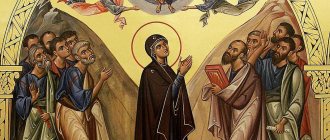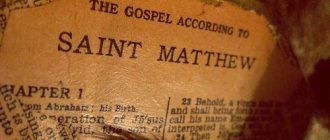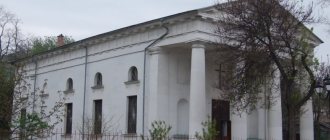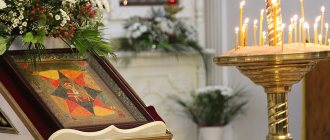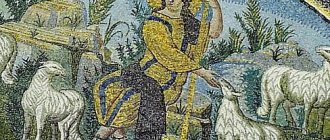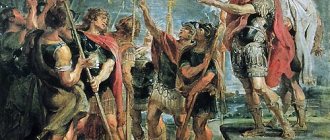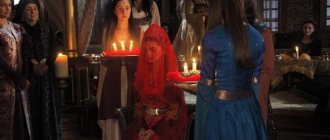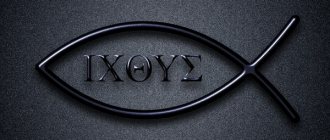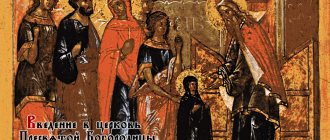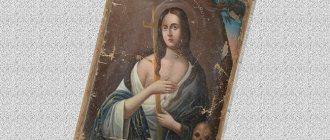- The first icons - what inspired the masters?
- Characteristic features of the Mother of God relics
- “Eleusa” – boundless love and tenderness
- "Hodegetria" - the path to salvation
- “Oranta” – Mother of God praying for people
- "Panahranta" - a sign of the highest glory
- “Agiosoritissa” – Intercessor of the human race
Looking at church shrines, believers have long felt spiritual awe, empathy, reverence and joy. This is facilitated by the very manner of writing, because all works of Orthodox icon painting are expressive, spiritual and filled with deep meaning. Every element of the image has meaning: the position of the hands, the pose and even the color of the clothes! Only knowing what they symbolize will you be able to penetrate deeper into the essence of the relic, understand it and comprehend it. And our article will introduce you to the history of the appearance, interpretation and types of the most revered images on which the Mother of God herself is depicted.
Characteristic features of the Mother of God relics
There are about 860 different versions of the images of the Virgin Mary, of which approximately 260 are considered revered and miraculous. However, any of the shrines must have common features - thanks to them, it becomes recognizable and canonical, be it the “Sign” icon of the Mother of God or the “Panahranta” relic. Here are the main features of Orthodox works dedicated to the Madonna:
- The halo of the Heavenly Queen is written round. Unlike the attribute of Jesus, it does not have a cross, but the halo can be supplemented with twelve stars, a diadem or a radiant crown;
- next to the head of the Blessed Virgin, an inscription in Greek letters “Μ ҃Ρ Θ ҃Υ” is placed, meaning “Mother of God”. Sometimes naming is also done in Church Slavonic - MN BZHN. And the Savior is denoted by the letters IC XC, ΙΣ ΧΣ, IСЪ ХСЪ, ΙΧΘΥΣ, or ο ων;
- The clothes of the Virgin Mary are designed in two colors - red, symbolizing Her royal origin, and blue or light blue (a sign of purity, perfection and peace). The main detail of the vestment is the maforium - a head cape that also covers the shoulders and back. Since 474, the top veil of the Madonna has been kept in the Blachernae Cathedral in Constantinople;
- The vestments of the Virgin Mary are decorated with three stars. They personify Her purity and chastity, and also serve as a reminder of the Holy Trinity. Therefore, Jesus, sitting in the arms of the Heavenly Queen, often covers one of the stars - this is how the master shows that the Son of God was the Incarnation of the Eternal Lord;
- the insignia of the Mother of God were copied from the vestments of priests. This detail symbolizes the service of the universal church to the Heavenly Bishop - Jesus Christ.
Orthodox masters depict the Most Pure Virgin as sad, but this feeling is always full of spiritual strength, wisdom, and reverence. She can solemnly reveal the Savior to the world, gently press Him to her, or easily support Him. It is on the basis of such differences that the following types of images are distinguished.
Ark with particles of the vestments of the Blessed Virgin Mary
The clothes that, according to legend, covered the Most Holy Theotokos during her life and at the Assumption occupied a special place among the shrines of Constantinople. Most of them were housed in the palace complex in Blachernae, where they were kept along with the famous miraculous images of the Virgin Mary. The robes, called "Robes" and "Veils", are believed to have been either part of a long mantle that was placed on the head and hid the figure to the knees, or a short scarf that covered only the head or fell to the shoulders. In Blachernae, pilgrims also saw the povoy, or skufia, of the Mother of God. This relic is usually associated with a small headdress worn over the maforium and well known from iconography. Thus, the pilgrim Stefan Novgorodets notes: “I went to Lakherna, to the church of the Holy Mother of God, where the Robe and Belt and Skufia lie, which was on its head.” The latter item was clearly different from the Robe and the Veil and, indeed, could be depicted on icons as some kind of additional headdress, owing its origin to a specific Byzantine relic.
The history of the acquisition and veneration of the clothes of the Mother of God is not always clear; this question awaits its painstaking researcher, but here you can find several recurring themes in the Tradition.
The history of the appearance of the Mother of God shrines in Constantinople is based on written evidence, which gives reason to think about the transfer to Constantinople of at least two different outer garments of the Mother of God - Her Robe and the Intercession, and, apparently, placed at different times in the churches of the Blachernae complex. This follows both from historical works and from homiletical works intended for reading on the holidays of the Placing of the Robe - July 2 and the Dormition of the Virgin Mary - August 15. Regardless of which of these days the reading took place and which of the texts the compilers of the Minology turned to, the history of the clothes had to go back to the last days of the life of the Mother of God and Her Dormition. Consequently, the established tradition of their veneration could have arisen no earlier than the time of the formation of theological and dogmatic ideas about this event and the official registration of the holiday on August 15. They were based on non-written information, literary fixed by the 5th-6th centuries and assimilated by the witness of the last days of the life of the Mother of God, the Apostle John the Theologian, and his disciple, the 2nd century Bishop Melito of Sardia. Subsequent works are based on the descriptions of events presented in them. Tradition associates them with various authors, first of all Joseph of Arimathea, and later with John, Archbishop of Thessalonica. After the official establishment of a new holiday dedicated to the Dormition of the Blessed Virgin (which supposedly took place under the Emperor Mauritius (592-602)), church writers composed homilies and solemn words for it, explaining and glorifying the miracle of the Dormition and Ascension of the Virgin Mary. It was they who primarily influenced the iconography of the holiday. The patristic homilies, which proclaimed the truth of the apostolic witness, became the canonical texts on the Assumption, but they were also written on the basis of earlier apocryphal writings. The increase in literature dedicated to the Assumption occurred in the 8th-9th centuries, when a wide layer of hymnographic works was formed that were included in the final readings of the service of this day.
Robe of the Virgin Mary
The “Tomb Garments” of the Mother of God are mentioned in the “Sermon on the Dormition” of John, Archbishop of Thessalonica, compiled between 610 and 630. Describing the last hours of the life of the Mother of God, the author assigns a special role to the Apostle John the Theologian. Delighted from Ephesus by the Holy Spirit, the Apostle is the first to learn about the imminent death of the Blessed Virgin Mary, who asks to preserve Her body from hostile Jews and leads him “to her storehouse, showing him the funeral Robes, and everything in her dwelling, saying: “Child of John, Consider that the imam is nothing on earth, except for his two funeral robes, and there are two widows here, and when I leave the body, give one to each of them." Having commanded her two Robes to widows, Mary herself testifies that they are Her funeral robes. According to the “Tale of Melito of Sardis,” having received the news of the Assumption from an angel, She dressed in these “new clothes,” which will remain in the tomb after she “departs from the body” and ascends in the flesh. “Everything that is funeral,” together with the palm branch brought by the angel, she shows to all the other apostles gathered in Her house. There is no doubt that it is they who are seen in the empty tomb in Gethsemane by the Apostle Thomas, who did not make it to the Assumption and appeared only three days after the burial. The reference to the Apostle Thomas and other details allow us to think about the appeal of John of Thessalonica to the Latin edition of the “Tale” of the 5th century, attributed to Melito of Sardia. A number of important details are contained in another Latin legend about the Dormition of the Mother of God, the legendary author of which calls himself Joseph of Arimathea. It says that the body of the Virgin Mary, laid in the crypt of the Valley of Jehoshaphat, was taken by angels to heaven. Thomas, who saw this, miraculously transported to the Mount of Olives from India, prayed to the ascending Mother of God for a blessing, and then the belt that encircled the body during burial fell at his feet. The apostles did not believe Thomas’s story and, in order to convince the unbeliever, they opened the coffin, but it turned out to be really empty. In the belt they received, they recognized the ribbon with which the mortal Robes of the Blessed Virgin Mary were fastened. Thus, the belt should also be attributed to the complex of funeral clothing. The tradition about the abandonment of the Robe by the Mother of God, set forth in the “Sermon” of John of Thessalonica, is used by the Monk John of Damascus in the “Second Homily on the Dormition of the Theotokos.” At the end of his homily, Saint John cites Chapter III of the book of the so-called “Euphemian History”, containing a story about the construction of a church in Blachernae in honor of the Mother of God undertaken by Empress Pulcheria and Emperor Marcian and their desire to transfer Her body there, just as the relics of saints were transferred to dedicated them temples. They turned to the Bishop of Jerusalem Juvenal, who was in Constantinople on the occasion of the Council of Chalcedon that was then taking place: “We want to transfer these remains here under the protection of the reigning city.” Referring to an ancient and most reliable tradition, the hierarch spoke about the meeting of the apostles and the opening of the tomb: “...one of them, who was absent and arrived after the third day, wished to venerate the God-receiving body. But they could not find Her all-sung body, so, having found only the funeral robes lying there and being filled with the indescribable fragrance emanating from them, they closed the coffin. Hearing this, the kings asked the bishop to send them that holy coffin sealed, along with the shrouds and clothes of the Glorious and Most Holy Theotokos Mary. And, having received it, they placed it in the sacred temple built in honor of the Most Holy Theotokos in Blachernae.” The above passage from the 18th chapter, known from all the earliest manuscripts of the “Slovo,” was borrowed by the Monk John from the so-called “Euphemian History” - the biography of Abba Euthymius (†472), who lived in Palestine during the Council of Chalcedon. The appearance in it of an episode with the opening of the tomb of the Mother of God and the discovery of a relic - the Robe - is quite understandable: it was precisely at this time that ideas about the Dormition of the Mother of God crystallized in the Church. It was necessary to trace the connection between the Robe kept in Blachernae and the legend about the funeral robes discovered by the apostles in an empty tomb and identify them with the true clothes of the Most Pure One. Thus, the general legend about the origin, acquisition, transfer and position of the Robe in Blachernae was already formed by the middle of the 6th century. It testified to the funerary nature of the garments, their discovery in an empty tomb that did not preserve the body of the Virgin Mary, and the transfer of the Robe from Gethsemane to the House of the Virgin Mary in Blachernae. Apparently, Blachernae was perceived in Constantinople as a repetition, a kind of icon of the Gethsemane tomb, which led to the creation of the Holy Reliquary here, in which the “grave shrouds” were placed. One must think that this was not the real tomb of the Virgin Mary, which remained in Jerusalem, but its likeness.
The story of the transfer from Palestine to Constantinople of the robes of the Mother of God, which, according to legend, she herself bequeathed to two widows who lived with her before her death, is contained in the “Sermon on the position of the Robe of the Mother of God in Blachernae” by Theodore Sincellus, a presbyter of the Great Church, which he delivered on the feast day of July 2 between 620 and 625 years. The first part of his work, following a rather extensive and florid introduction, in which the author praises Blachernae and the shrines kept there, is a retelling of the ancient, and probably by the beginning of the 7th century, already well-known story about the transfer of vestments from Palestine.
Protection of the Virgin Mary
According to the most frequently repeated tradition of description, according to the testimony of the 14th century monk-historian Nicephorus Callistus, the Protection of the Most Holy Theotokos was acquired during the reign of Emperor Leo the Great (457-474). The brothers Galvius and Candide, traveling to Palestine to worship holy places, found the robe of the Most Holy Theotokos there in the house of a Jewish maiden. The story, retold by Theodore Sincellus, says that the two brothers reached Palestine and headed to Galilee to visit Nazareth and Capernaum. They stopped for the night in a small village, where they found shelter with an old Jewish woman, “shining with her purity and benefactors.” Noticing during the evening meal that the inner room of the house was “sanctified by many lamps and fragrant with the world of numerous censers,” they asked about the reason for such decoration. The woman told them that miracles of healing were happening in her house from the emanating “unearthly light” and fragrances, but she kept silent about the source of these miracles. Having received confused and evasive answers from the hostess, Galbiy and Candide persistently asked to reveal the secret. As the author of “The Lay” narrates, she said with tears and groans that no one should have known the sacred secret conveyed to her “under an oath to her ancestors.” She decides to talk about him, since she is the last maiden in their family and therefore the last legal owner of the shrine. In the ark, which “shines with an unearthly light and is fragrant” in her back room, the clothes of the Most Holy Theotokos are kept, which She, before her death, as Her mercy, bequeathed to the virgins who lived with her in the same house. The woman who maintained her virginity came from the family of one of them, which is why she inherited such a great shrine. In the lists of the widespread edition, a remarkable detail is included in the story: the robe stored in the house retains traces of the Mother of God’s milk from the time when she fed the Infant Jesus, which clearly emphasized that it has nothing to do with funeral attire. Noteworthy is the detailed detail that this attire was passed down from generation to generation to those representatives of families who took upon themselves the feat of virginity. Whereas the Mother of God bequeaths funeral Robes to widows from her entourage.
The brothers asked the hostess for the opportunity to spend the night at the great shrine; in tears and prayer they thanked the Mother of God for what they saw and heard. After making sure that everyone was asleep, Galbius and Candide measured the reliquary, noting what kind of wood it was made of. Arriving in Jerusalem, the brothers distributed alms to the poor and ordered an exact copy of the ark. On the way back they were again allowed to spend the night in the inner room and, as before, they prayed fervently, asking the permission of the Mother of God to move the shrine to Her own city - the king of all cities, for the sake of its safety and glory. The brothers replaced the reliquary and went to Constantinople. Fearing that they would lose such a treasure without telling either the primate of the Church of Constantinople or the emperor about it, with the favor of the Mother of God, Galbius and Candide erected a small temple in the name of the Apostles Peter and Mark near their home in the Blachernae quarter. However, the miraculous intervention of the Most Holy Theotokos still forced the brothers to talk about the shrine. Having received such a great gift and filled with joy, Emperor Leo and his wife Verina erected a temple in Blachernae in honor of the Mother of God and placed the brought clothing in it, placing it in a reliquary made of gold and silver - the Holy Ark. The style of the solemn “Word”, written by Theodore Sincellus around 620, indicates that by the first quarter of the 7th century this relic already had a rather long and, we note, not very clear history of veneration. He also acquires his own name among the robes of the Mother of God, which has a Slavic and specifically Russian translation - Intercession.
Veneration of shrines
Thus, the sources reveal the burial and lifetime robes of the Mother of God, which ended up in Constantinople at different times and under different circumstances. These circumstances gave originality to the veneration of each of them, which had already developed by the 7th century. The construction of the shrine and the transfer of burial shrouds from Jerusalem are associated with the names of Pulcheria and Marcian, who built the House of the Most Holy Theotokos in Blachernae around 450 and placed the Robe there. Readings about this occur in minologies and holiday homilies on August 15 - the day of the Assumption. If we turn to the data of historical chronicles and written sources, the Blachernae Temple was indeed created by Pulcheria at the beginning of the reign of Marcian, between 450 and 453. Nicephorus Callistus (c. 1320) is especially detailed in his description, relying on various sources, in this case rather on the “Euphemian History”. He points out that the funeral shrouds of the Mother of God were sent by the Jerusalem primate of the Church Juvenalius to the wife of the Emperor Marcian (450-456) Pulcheria, who built a temple for them in Blachernae, solemnly placed the shrines there and established a night vigil and a procession on Wednesdays between him and the church in Chalcopratia, which keeps the belt of the Mother of God as a treasure. Nicephorus Callistus clearly speaks of two Blachernae temples - the Great Basilica, built by Pulcheria for the burial clothes of the Mother of God, sent from Jerusalem, and the round chapel, erected by Emperor Leo (457-474) for Her attire, often called both the Veil and the Robe and delivered to Constantinople by Galbi and Candide. The transfer of this lifetime robe of the Mother of God - the Veil, which, judging by the story of Galbi and Candide, She wore during the infancy of Christ, is associated with the reign of Emperor Leo I (457-474) and his wife Verina, who solemnly placed the shrine in a silver reliquary on the throne the temple erected and decorated by them in Blachernae. Texts dedicated to this event are most often placed in the synaxars on July 2, the day of the Placing of the Robe, but are also included in the readings on August 15.
Thus, we observe in the history of the Church two significant relics associated with the Mother of God. After the sack of Constantinople in 1204, the great Christian shrines were transferred to the West, although it appears that part of the Robe remained at Blachernae and a new tradition of veneration developed around the surviving relic. Josephus Brennius lists the Robe and the Belt of the Virgin among the relics remaining in Constantinople after the Latin conquest. In any case, in the fire of 1434 the church in Blachernae perishes and is no longer mentioned. There are only a few years left before the fall of Constantinople. The bulk of the relics stolen by the crusaders will find their places in public and private churches and chapels in Europe.
However, a number of shrines come from Constantinople to the West in a completely legal and pious manner. So, for example, in the 9th century, the Byzantine Empress Irene sought rapprochement with Charlemagne in order to unite the Second Rome - Constantinople and the Western Empire of Charles, formed in the 9th century, into a single whole. To this end, active negotiations are underway, including on the conclusion of a dynastic marriage between the rulers of the East and West. As a sign of her special favor, Empress Irene gives the ark with the Intercession of the Mother of God as a gift to Emperor Charlemagne. In 876, Charlemagne's grandson, Charles II, donated the shrine to the city of Chartres.
The Protection of the Most Holy Theotokos attracts many pilgrims to the city. The historical chronicles of Chartres tell us about two great miracles that occurred through the prayers of the Blessed Virgin Mary. In 911, when a detachment of pagan Normans, who were mercilessly destroying the cities of Europe, was advancing on a poorly fortified city, Bishop Ganthelm and the townspeople, with a prayer for intercession, hung the Protection of the Most Pure One on the walls of the city and the Mother of God, just as it was in Constantinople, intercedes for the city . A miracle happens - the ferocious “people from the North” take flight and never attack the city again, and the leader of the Norman detachment converts to Christianity.
The second miracle, also connected with the history of the city of Chartres, occurs in 1194, when the Romanesque cathedral of the 9th century was practically destroyed in a terrible fire. For three days the flames did not subside, and the city was already mourning the loss of the revered and beloved Shrine. But, to the amazement of the townspeople, on the third day three monks emerged from under the ruins, and at the moment when the flames engulfed the temple, they buried themselves in the crypt of the cathedral along with the Intercession. The fire raged all around, but it did not touch the Shrine and the people who kept it. This miracle inspired the townspeople to build a new temple. Construction of the new Chartres Cathedral took 26 years and was completed in 1220. During the French Revolution, in order to save the Shrine, it is divided into several parts. Risking their lives, pious Christians keep it for themselves.
In 1819, the largest of these fragments was returned to Chartres Cathedral. In 1927, an examination was carried out, as a result of which it was established that the Chartres fabric dates back to the first centuries and corresponds to the technology of Palestinian weaving of the 1st century. “During the research,” the examination report says, “no facts were revealed that refute the assumption that the Virgin Mary was wearing this particular fabric at the time of the birth of Jesus Christ.”
The Center for the Study of Orthodox Shrines of the Russian Orthodox University had the opportunity to compare small parts of the Mother of God relics in different churches in Europe - with particles of vestments located in the university church of the Apostle John the Theologian near Elm - they correspond to similar shrines. However, in the context of the aforementioned somewhat unclear global history of the acquisition and storage of the Mother of God shrines, a special role is played by the discipline of the continuity of the transmission of relics. Bishops were personally responsible for the correct transfer of relics. Particles of the vestments of the Mother of God transferred to the Church of the Apostle John the Theologian near Elm, which were kept in Western Europe before being transferred to the Russian Orthodox University, have been sealed by the bishops.
Taking into account the above, reading the accompanying documents and inscriptions in the reliquaries indicates that they contain part of the burial shrouds of the Mother of God, which in the Slavic church tradition received the name of the Robe and parts of the maforium - the Intercession.
M.V. Arteev,
Head of the Study Center
Christian shrines of RPU
“Eleusa” – boundless love and tenderness
On shrines belonging to this type, the Savior is depicted leaning against the cheek of the Virgin Mary. The touching faces express the closeness of heavenly and earthly, material and spiritual.
Such images convey communication between Jesus Christ and the Virgin Mary, filled with understanding, happiness and empathy. However, sadness is visible in the gaze of the Heavenly Queen - she knows what fate awaits Her Son, and submits to the Lord’s will. In addition, the relic serves as the embodiment of Divine mercy shown to every sinner.
How does the icon of the Mother of God “Tenderness” help? Such shrines - among them the Pochaev and Vladimir relics, as well as the images of “It is Worthy to Eat” and “The Leaping of the Baby” - help strengthen faith, relieve difficult and sorrowful experiences, and reconcile rivals and enemies. They bless newlyweds - it is believed that then peace, harmony and understanding will reign in the house.
Kazan Icon of the Mother of God
Perhaps the most famous Orthodox icon in general. At least, definitely the most media one. However, most unchurched Orthodox Christians have little idea why the “Kazan” icon.
She appeared to the girl Matrona on the ashes of burned Kazan in 1579. At the site of the apparition, the Mother of God Convent was built. It was with this icon that the militia soldiers of Minin and Pozharsky later fought off the Polish-Lithuanian troops.
Afterwards, this icon helped defeat Napoleon, Hitler’s Germany, and one image of Our Lady of Kazan even went into space. The icon still patronizes soldiers; people pray to it for the protection of military personnel. In addition, Our Lady of Kazan heals the weak, relieves blindness and consoles in any conflict situation.
"Hodegetria" - the path to salvation
In images made in this manner, the Most Pure Virgin holds the Savior on her left hand, pointing at Him with her right hand. The views are directed towards the viewer, and Jesus Christ is the center of attention. Such a composition personifies the coming into the world of the Heavenly King and Judge, reminds us of the duty of every Christian, and calls for turning our thoughts to the great sacrifice of the Lord.
According to church traditions, the first of these shrines was written by the Apostle Luke. Since then, many similar relics have appeared - for example, the Kazan, Iverskaya, Czestochowa and Tikhvin icons, the images “Support of Sinners”, “Three-Handed”, “Quick to Hear”. By calling on them, believers can make the right decision, find hope, calm anguish, grief and sorrow, protect themselves and their loved ones from illnesses and troubles.
Smolensk Icon of the Mother of God
Also written by the Evangelist Luke and also arrived on Russian soil from the first center of Orthodoxy - Constantinople. According to legend, the icon arrived in Rus' together with Princess Anna, the future wife of Prince Vsevolod. His son, Vladimir Monomakh, who founded the Church of the Dormition of the Blessed Virgin Mary in Smolensk, transported the image to Smolensk. There the icon, considered a symbol of the protection of the Russian land from the west, was located until 1943 (during the Polish-Lithuanian period it was preserved in Moscow). After the capture of Smolensk by the Nazis, the icon disappeared. But the Nazis were still defeated.
They pray to the Smolensk Icon of the Mother of God, asking to protect Rus' and loved ones from terrible epidemics, bloody wars and all adversities. The face of Our Lady of Smolensk also warns against family adversity; turning to her can resolve family conflicts.
“Oranta” – Mother of God praying for people
This iconographic scheme, also known as the “Sign” (in honor of the defense of Novgorod from the regiments of Andrei Bogolyubsky) or “Panagia” - “All-Holy”, belongs to the earliest. Mentions of such a prayer position are found in the Old Testament, and the first drawings of the Virgin Mary with her arms raised and outstretched to the sides are found already in the Roman catacombs.
The shrine looks majestic and monumental, so a static and symmetrical composition is often included in wall paintings and mosaics - for example, this is how the Cathedral of St. Sophia of Kyiv was decorated in the 11th century. Such relics can be shoulder-length or waist-length, but sometimes there are also full-length figures. In addition, the icon of the Mother of God “Oranta” is traditionally placed at the top of the altar. It can be an element of more complex works dedicated to the Feasts of the Intercession or the Ascension, or it can be complemented by the face of Christ Emmanuel, inscribed in a round medallion at the chest level of the Madonna.
The meaning of this image is the intercessory prayer of the Most Pure Virgin, Her protection and patronage. This shrine also reminds believers of the Annunciation, the Nativity of Christ and subsequent events, right up to the Second Coming.
How does the icon “The Sign of the Blessed Virgin Mary” help? It protects the home and family from any adversity, troubles and problems, supports in difficult times, gives hope and new strength. Varieties of this relic are the “Unbreakable Wall”, “Inexhaustible Chalice”, Kursk, Novgorod, Yaroslavl shrines.
Vladimir Icon of the Mother of God
Less “media”, but very revered miraculous icon. This is one of the oldest icons that came to Rus'. Orthodox believe that the image was painted by the Apostle Luke, after which it came to Jerusalem and then to Constantinople.
Subsequently, the icon found its place in Kyiv, where it received the name of the Vyshgorod Mother of God. After Prince Andrei Bogolyubsky transported her to Vladimir, she received her current name.
The Vladimir icon saved Rus' from the invasion of the Horde. Most of the miracles associated with it happened in one way or another during difficult times, requiring strength in faith and making difficult decisions. Therefore, they pray to Our Lady of Vladimir to strengthen faith and ask her for wisdom in ambiguous situations.
"Panahranta" - a sign of the highest glory
On such icons, the Mother of God appears in the guise of the All-Tsarina - She sits on a shining throne, holding the baby Jesus on her lap. This composition symbolizes the greatest dignity and honor that believers show to the Madonna.
Prayer at these shrines (among them the images of the “Sovereign” and “The All-Tsaritsa”) helps to free oneself from alcohol or drug addiction, cures any diseases, and saves from witchcraft and slander.
Tikhvin Icon of the Mother of God
Also written by Luke. It should be understood that in the Orthodox tradition, all early icons according to the canon of the hodegetria are considered to have been painted by Luke, who laid the foundations of this style. The icon appeared to believers in different places 7 times, walking through the air. For the seventh time she appeared at the Tikhvinka River. At the moment, the Tikhvin Assumption Monastery is located on this site, where the icon remains to this day.
She is especially revered by women, as she is able to treat infertility and protects during childbirth; prayer to her can heal women’s ailments. Protects small children from harm.
Feodorovskaya icon of the Mother of God
Found by Saint Theodore Stratilates on a pine tree in the city of Gorodets. Despite the fact that the cathedral in which it was located, Kostroma, was destroyed by fire twice, it did not burn down. Eyewitnesses say that the icon darkened shortly before the renunciation of the passion-bearer Nicholas II.
They read a prayer to the Feodorovskaya Icon of the Mother of God about the health of their children, as well as about everything that makes their souls heavy. Prayer can help a believer in raising a God-fearing child; parents of teenagers with torn souls turn to it for advice.
Kaluga Icon of the Mother of God
Found near Kaluga by the maids of a local landowner. One of the maids was of an obstinate nature - thinking that the canvas depicted the abbess of the local monastery, she spat on her, from which she immediately fell half dead.
But the Mother of God appeared to the mother of the daring woman, saying that the canvas depicted the mother of Jesus. And, like a mother’s mother, she advised holding a prayer service in front of the canvas and sprinkling the half-dead woman with holy water. After which the girl was healed.
They pray to the icon, asking for protection for the paralyzed, injured, blind, deaf, and those suffering from chronic illnesses.
